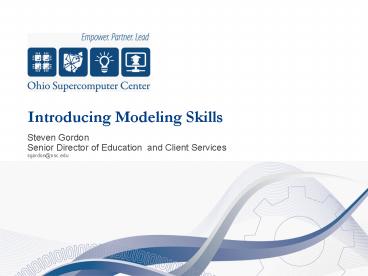Introducing Modeling Skills - PowerPoint PPT Presentation
1 / 11
Title:
Introducing Modeling Skills
Description:
Using the model to provide evidence to draw conclusions about a real world practical problem ... for a range of forecasts. Sometimes referred to as model ... – PowerPoint PPT presentation
Number of Views:39
Avg rating:3.0/5.0
Title: Introducing Modeling Skills
1
Introducing Modeling Skills
- Steven Gordon
- Senior Director of Education and Client Services
- sgordon_at_osc.edu
2
Goals of the Session
- Work through an example presentation and exercise
that introduces many modeling concepts - Modeling terminology e.g. parameters, constants,
validation - Conceptualization of the model framework and
model assumptions - Mathematical form of the model structure
- Linear vs. non-linear representations
- Implications of the mathematical structure for
model behavior - Using the model to provide evidence to draw
conclusions about a real world practical problem
3
Introducing Modeling Skills
- Tied to a general course in modeling and
simulation that is part of an undergraduate minor
program - More information at http//www.rrscs.org/minor/ind
ex.shtml - Competency-based course
- Focus on basic modeling skills
- Understanding of modeling process
- Accuracy and precision
- Mathematical representations of physical phenomena
4
First Modeling Exercise
- Model of the time it takes to get from your house
to a place of work using alternate routes - Possible Objectives
- Minimize the time it takes
- Avoid traffic congestion
- Avoid freeways (old car)
- Go by a friends house, restaurant, etc.
5
Conceptual Model
- List all variables of importance
- Define cause and effect relationships
- From scientific evidence or theories
- From physical laws
- From our own ideas
- Estimate nature of the relationship, form of the
relationship, and quantitative estimate
6
Weather and Traffic
7
More Modeling Ideas
- Assess the accuracy of our model
- How close does it come to the real answer?
- How would we measure this?
- Simplify the model eliminate some variables
from consideration - Decide which conditions represent the majority
of cases - Leave out other conditions to be modeled at a
later time
8
Still More Ideas
- Hold some variables constant for a range of
forecasts - Sometimes referred to as model parameters
- Test the sensitivity of the results to changes in
the values of the parameters - Verify whether the calculations are done
correctly - Is the code correct? Is the computer algorithm
being used appropriately in the calculation? - Validate the model as accurate
- Compare the model results with experimental data
9
(No Transcript)
10
Conceptual Traffic Model
- Assuming we want to minimize the time it takes us
to go from home to work, what should be the
conceptual components of our traffic model? - Open file trafficmodel.doc to see the assignment
- Open Excel and open trafficmodel1.xls to see the
simple traffic model - Examine the model assumptions and setup
- Change the red light probability as instructed
and create a spreadsheet showing the results - Which route is preferred under which conditions?
11
Optional Extension
- Focus on the nature of the traffic flow versus
congestion relationship - Relationship is not linear as congestion
increases - Potential differences in results if highly
congested conditions exist - Opportunity to discuss the model limitations
- Forecasting with assumptions that are violated by
the conditions - Forecasting beyond experimental data
- Passing a critical point where physical
conditions or behaviors change significantly































